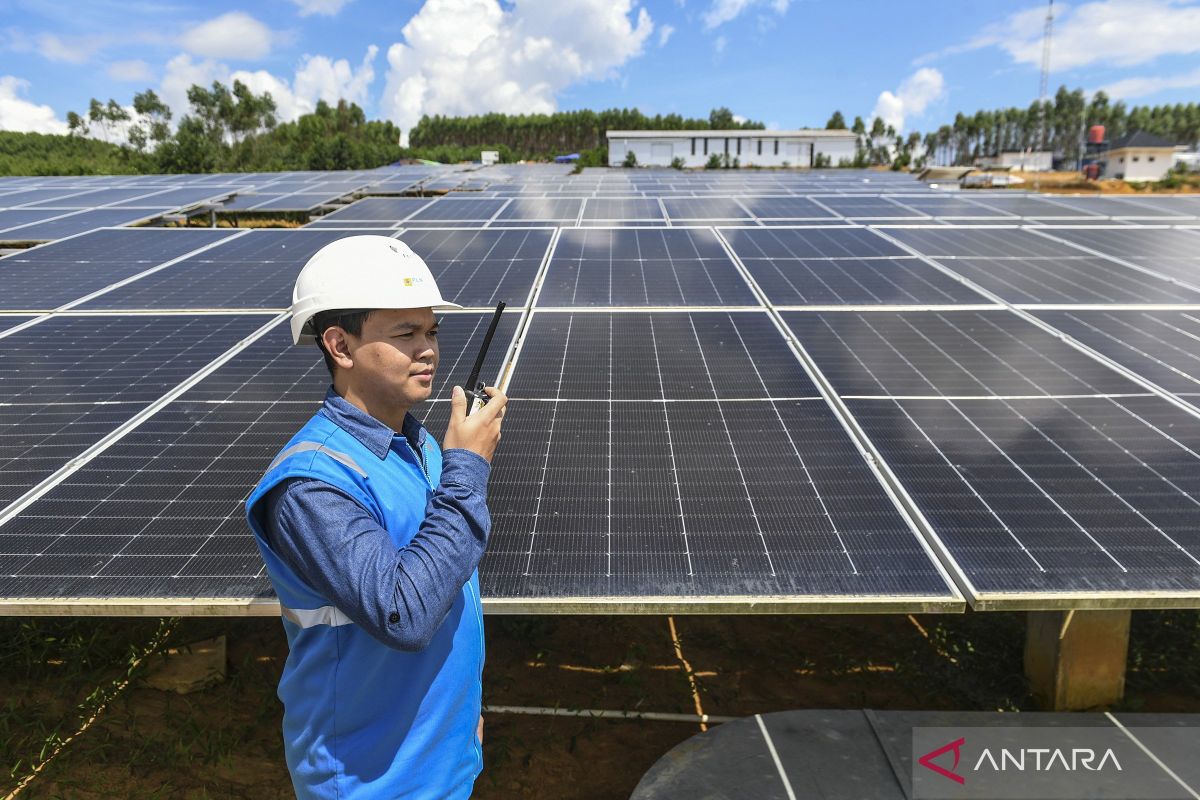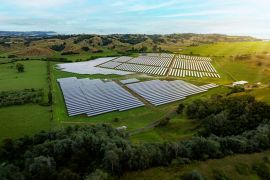At the Indonesia Solar Summit in Jakarta on August 21, 2024, Coordinating Minister for Maritime Affairs and Investment Luhut Binsar Pandjaitan emphasized the importance of expanding the development of the green energy industry, including solar energy, to maintain Indonesia's status as an energy exporter and build a sustainable energy industry.
This step is not only important to meet Indonesia's energy transition target, but also to reduce dependency on fossil fuel exports.
According to data from Bank Indonesia (BI) and the Ministry of Energy and Mineral Resources, Indonesia's fossil fuel exports in 2023 were significant at 518 million tons, valued at USD43 billion.
Meanwhile, the nation's pipeline gas exports reached 181 million British thermal units (MMBTu) and liquified natural gas (LNG) exports 474 million MMBTu, with a total value of USD8 billion.
Pandjaitan noted that Indonesia's renewable energy potential, including solar, wind, hydrogen, bioenergy, geothermal, and ocean energy, is very large.
The country's solar potential alone stands at 3,286 GW, while the potential for wind, hydrogen, bioenergy, geothermal, and ocean energy is 155 GW, 95 GW, 57 GW, 24 GW, and 20 GW respectively. However, renewable energy production is currently still limited at just around 7 GW.
To develop the green energy industry, Indonesia established cooperation with Singapore last year to develop the renewable energy industry, including the production of solar panels and battery energy storage systems (BESS).
The cooperation has attracted significant investment in the green energy sector, particularly in the development of solar power plants (PLTS) and battery supply chains.
The total investment reached tens of billions of US dollars, including USD30 billion–USD50 billion from energy development companies, USD1.7 billion from solar panel manufacturers, and USD1 billion from battery and inverter manufacturers.
Minister Pandjaitan also highlighted the importance of developing the domestic solar panel manufacturing industry to cut dependence on imports.
State-run electricity company PLN is planning to establish communication with global solar panel manufacturing companies to attract investment and build factories in Indonesia, in line with the government's efforts to increase the use of local components in renewable energy projects.
Realization and development
According to data from the Ministry of Energy and Mineral Resources, the realization of the installed capacity of Indonesia's renewable energy power plants in 2023 reached 13,155 MW or 13.16 GW.
The largest capacity was recorded in hydropower plants (PLTA) at 6,784 MW, followed by bioenergy power plants (3,195 MW) and geothermal power plants (2,417 MW). While the potential for solar energy is huge, namely at 3,300 GW, its realization reached just 573 MW.
In 2023, the additional capacity of PLTS was recorded at 290.69 MW, comprising 30.09 MW from ground-mounted solar panels, 68.06 MW from rooftop solar power systems, and 192.54 MW from floating PLTS.
To boost the use of solar energy, the government is currently accelerating the development of PLTS as a renewable energy solution.
PLN recently signed a power purchase agreement with Saudi Arabian power generation company ACWA Power for the development of the Saguling Floating PLTS in the Saguling Reservoir, West Java, with a capacity of 60 MW, which is expected to start operating in 2025.
Similar projects will be pursued in Lake Singkarak, West Sumatra, with a capacity of 50 MW, and Karangkates, Malang, East Java, with a capacity of 100 MW.
Indonesia has the potential to develop floating PLTS on lakes and dams at around 325 locations. Based on data from the Ministry of Public Works and Public Housing, floating PLTS can be developed on 259 dams with a potential capacity of up to 14.7 GW.
Challenges and solutions
Executive director of ReforMiner Institute, Komaidi Notonegoro, highlighted the challenges faced in renewable energy development, such as PLTS being highly dependent on weather conditions.
Therefore, PLTS need conventional generators for backup power at night, which can significantly increase operational costs.
"The problem is not only emissions but also costs. Imagine, if we have PLTS with 5 GW capacity, we also need other generators with 5 GW capacity for backup. It means we have to spend twice as much to produce the same amount of electricity," he explained.
To this end, the development of new renewable energy (NRE) needs strong commitment and even further intervention from the government. Moreover, NRE development in Indonesia is facing unbalanced market conditions and high-risk, low-return situations.
Notonegoro said that currently, many renewable energy developers are facing difficulties in selling their products because there is only one main buyer, namely PLN.
He suggested that the government carry out interventions in renewable energy development, including interventions for PLN.
Such interventions are considered necessary to ensure that PLN, as the off-taker, is willing to buy electricity from renewable energy developers at reasonable prices.
If PLN is unable to buy all the electricity generated, the government will need to put a power-wheeling mechanism in place so that renewable energy developers can sell electricity to other parties.
Power wheeling is a mechanism for transferring electrical energy from private generators to state-owned/PLN operating facilities by utilizing PLN's transmission/distribution networks.
"If power wheeling is not possible, the government must provide subsidies. Thus, there must be a guarantee that the electricity produced by renewable energy developers is 100 percent absorbed," he said.
Meanwhile, executive director of the Institute for Essential Services Reform (IESR), Fabby Tumiwa, said that Indonesia needs to develop the value and supply chains for the solar PV industry to realize the great potential of solar energy as the backbone of the national energy transition and become a solar hub in Southeast Asia.
There are several reasons why Indonesia needs to build value and supply chains for the solar PV industry.
First, as a country with a middle income and a large population, Indonesia's energy needs will continue to grow. Investment in solar PV can ensure energy sufficiency while also reducing carbon emissions, thereby contributing to global efforts to combat climate change.
Second, the development of the solar PV industry can create a broad industrial ecosystem, including creating new jobs, innovations, and technology transfers.
Furthermore, it can also bolster the supply chains for the production of polysilicon, wafers, solar cells, and solar modules, as well as related component industries such as the glass industry, which will encourage the growth of local industries and reduce reliance on imports.
Third, the current global conditions have opened up opportunities for Indonesia to attract foreign investment, like in the case of the electric vehicle battery industry. Indonesia can position itself as a solar PV hub in Southeast Asia, which is expected to spur economic growth and technological advancement.
Tumiwa emphasized that the solar PV industry is capital-intensive, intensely competitive, and high-risk. Therefore, the government needs to build a national strategy that includes a long-term plan and short-term and medium-term targets with clear and consistent policies.
In addition, a comprehensive policy framework, fiscal and non-fiscal incentives, and ease of licensing and land acquisition processes are also needed.
To boost domestic demand, it is advisable for the government to implement a mandate adoption policy, which would require the use of PLTS in buildings, public facilities, and projects funded by the state and regional budgets.
The government also needs to explore the possibility of exporting solar modules or electricity and support research and development of the latest solar technologies.
Building the solar PV industry and its supply chains is not only an opportunity but a necessity to support the sustainable energy transition in Indonesia.
By utilizing natural resources and a large market, Indonesia can create an investment climate that is attractive to investors.
More than that, it also has the potential to become one of the leaders in the global solar PV market, boost economic growth, and ensure a sustainable future for the next generations.
Related news: Govt powering remote areas with integrated solar power plants
Related news: Indonesia, Saudi firm to build floating solar power plant in W Java
Editor: Rahmad Nasution
Copyright © ANTARA 2024












